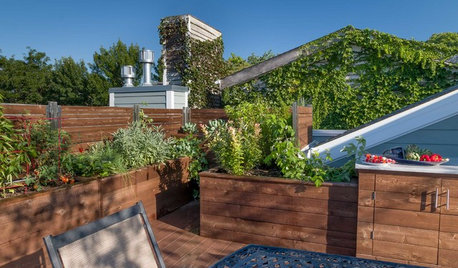My Fall Tomato Crop is In - - Now, 27 Container Mix Trials Begin!
rnewste
14 years ago
Related Stories

EDIBLE GARDENSSummer Crops: How to Grow Tomatoes
Plant tomato seedlings in spring for one of the best tastes of summer, fresh from your backyard
Full Story
EDIBLE GARDENS8 Surefire Vegetables and Herbs for Beginning Gardeners
Learn the edible plants that are popular and easy to grow in a backyard or container garden
Full Story
SPRING GARDENINGSummer Crops: How to Grow Strawberries
Pluck your own sweet strawberries right from the garden vine for smoothies, salads or eating then and there
Full Story
SUMMER FRUITS AND VEGETABLESSummer Crops: How to Grow Beans
Grow your own beans for amazing variety and healthy, convenient produce all summer
Full Story
EDIBLE GARDENSHow to Grow Your Own Sweet Summer Crops
This guide will help any gardener get started on growing the freshest warm-season veggies and berries for summer
Full Story
EDIBLE GARDENSSummer Crop: How to Grow Blueberries
Plant blueberries in spring or fall for garden beauty through three seasons — and a sweet superfood in summer
Full Story
EDIBLE GARDENSSummer Crops: How to Grow Pumpkins
Start in spring to grow your own fall decorations and have plenty left for pies
Full Story
SUMMER FRUITS AND VEGETABLESHow to Grow Your Own Fresh, Sweet Corn
Here's how to plant and care for your own mini cornfield
Full Story
GARDENING GUIDES10 Tips for Beginning Gardeners
With a simple sketch, basic tools and the right plants, you’ll be on your way to growing your first flowers or edibles
Full Story
FALL GARDENINGMake This Fall’s Garden the Best Ever
Learn the most important tip for preventing buyer’s remorse, plus get more valuable buying and planting advice
Full StoryMore Discussions






rnewsteOriginal Author
engineeredgarden
Related Professionals
Derry Landscape Architects & Landscape Designers · Norton Shores Landscape Architects & Landscape Designers · Anderson Landscape Contractors · Canyon Lake Landscape Contractors · Fort Atkinson Landscape Contractors · Morrisville Landscape Contractors · Rochester Landscape Contractors · Saint George Landscape Contractors · Bryn Mawr-Skyway General Contractors · Chillicothe General Contractors · Norristown General Contractors · Universal City General Contractors · West Mifflin General Contractors · Cape Coral Decks, Patios & Outdoor Enclosures · Renton Decks, Patios & Outdoor Enclosuresstruwwelpeter
rnewsteOriginal Author
struwwelpeter
engineeredgarden
liz63
chalstonsc
newgardener_tx
glchen
rnewsteOriginal Author
fulton
rnewsteOriginal Author
structure
rnewsteOriginal Author
rnewsteOriginal Author
struwwelpeter
ruet
rnewsteOriginal Author
engineeredgarden
rnewsteOriginal Author
liz63
rnewsteOriginal Author
tn_veggie_gardner
engineeredgarden
rnewsteOriginal Author
engineeredgarden
rnewsteOriginal Author
engineeredgarden
rnewsteOriginal Author
mickyfinn6777
rocky_acres
bencjedi
engineeredgarden
bencjedi
rnewsteOriginal Author
engineeredgarden
bencjedi
rnewsteOriginal Author
spaghetina
bencjedi
rnewsteOriginal Author
rnewsteOriginal Author
rocky_acres
rnewsteOriginal Author
mickyfinn6777
rnewsteOriginal Author
engineeredgarden
rnewsteOriginal Author
brancato